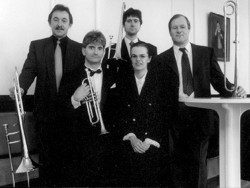Tallinn Baroque

Kaia Urb (soprano); Raivo Tarum (baroque trumpet); Priit Aimla (baroque trumpet); Aabi Ausma (trombone); Valter Jürgenson (trombone); Imbi Tarum (harpsichord); Peeter Margus (alto trombone); Olev Ainomäe (schawms)
The ensemble plays the music of the 17th and 18th centuries, when guilds of brass players were formed at churches and courts and they were given a privileged status. The musicians were obliged to serve either the king, the prince, the emperor or the church and not to perform anywhere else. It was believed that the sound of brass instruments - trumpets, cornets, trombones - best expressed the nobility of the royal throne as well as the divine might and nobility. Such guilds were active, for example, in Bologna, Venice - where the band of St. Marcus Church consisted only of trumpets, cornets and trombones, the court of Emperor Leopold in Venice and Salzburg as well as in Leipzig, Dresden, Nürnberg, Berlin and Hamburg.
During the baroque period the art of singing was considered to be the highest musical art, as the singers glottis is the most perfect of all instruments and besides voice the singer also expresses himself with the help of words. This is why the instruments resembling human voice were most highly valued. So it was believed that the sound of the trumpet resembles the voice of the soprano and the contra-tenor, the sound of the cornet resembles the voice of the chorister, the sound of the tenor trombone that of the tenor and the sound of the bass trombone the voice of the basso.
As in rule, there was always an accompanying instrument in the ensemble, which could be either a harpsichord or an organ. Both were also used as outstanding solo instruments.
All the above mentioned has determined the composition of our ensemble and the choice of repertoire. The ensemble performs on instruments belonging to the times when the music was composed. This provides the listener with a overview of the development of the instruments, their sound and playing possibilities during earlier times.



